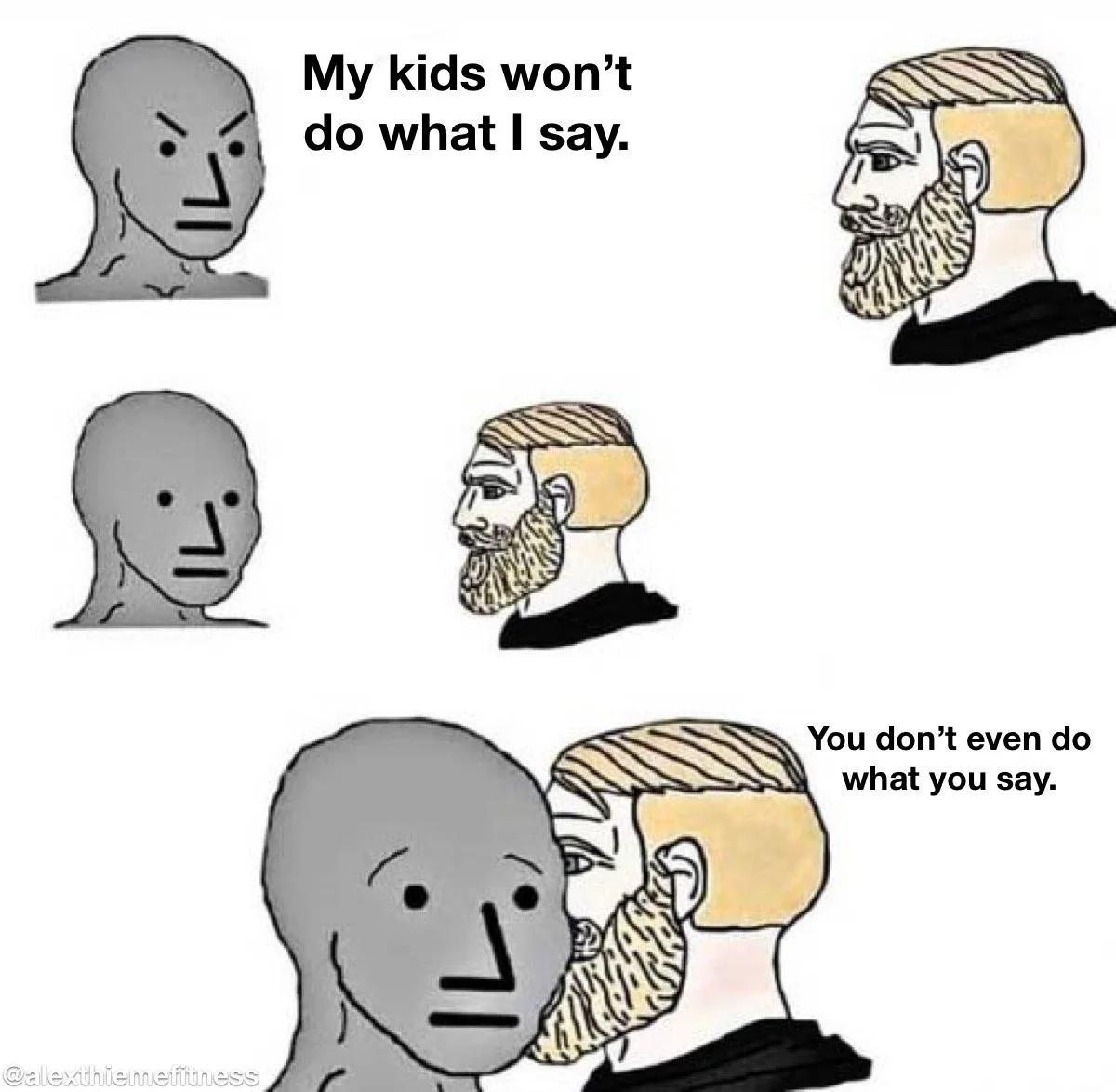How to Make Health and Fitness a Normal Part of Family Life
We often talk about fitness and nutrition like personal projects.
My goals. My plan. My results.
But at home, if you have kids, little eyes are noticing more than you might realize.
Every choice we make around food, movement, sleep, and stress becomes part of what “normal” looks like in our family. A walk after dinner. A quick lift in the garage. Vegetables on the plate and dessert without drama. None of it needs a speech. It just needs to be seen.
Health can be something the whole family practices together - casual, consistent, and without pressure.
Kids learn by watching, not by being told
The best thing for kids isn’t talking about eating vegetables or exercising - it’s seeing us actually do it.
When they watch you head out for a walk after dinner, cook a meal, or lift weights a few times a week, it sets a quiet standard for what “normal” looks like.
You’re teaching through action.
Invite kids into the kitchen
There’s something powerful about kids helping make the food they eat. It builds connection, confidence, and curiosity.
And it really doesn’t have to be fancy.
Let them pour, stir, measure, or wash vegetables. Ask them to choose the fruit for breakfast or the seasoning for dinner (age dependent, of course).
Cooking together isn’t only about nutrition - it’s about life skills, autonomy, and comfort with food.
And yes, it takes longer. There will be messes. But those moments of shared effort matter far more than a perfectly clean counter.
We regularly bring our toddler into the kitchen with us, starting when he was 12 months old. Sometimes he’ll stir ingredients for muffins and sometimes he just eats all the berries while standing at the counter, but either way he’s engaged in the activity.
Make movement a family norm
If exercise feels like another box to check, it’s hard to stay consistent. But when it becomes part of family life - something that’s fun, flexible, and built into the rhythm of your days - there’s a lot less friction.
This doesn’t mean dragging everyone to the gym. I can only imagine wrangling our son around a Planet Fitness.
But, it could look like:
Taking a family walk after dinner
Playing tag or kicking a ball around the living room
Signing up for a local 5k together (walking counts)
Letting the kids “lift” with you during a home workout
Kids don’t need structure to move - they need opportunity. When movement is part of the household culture, it becomes a lifelong habit.
Keep health about how you feel, not how you look
One of the most powerful lessons we can pass on is that health isn’t a punishment for how we look - it’s a privilege we get to practice.
That starts with how we talk about it.
Instead of “I need to work off this food,” try “I’m going for a walk to get some fresh air.”
Instead of “I shouldn’t eat that,” try “I’m adding some vegetables to feel good.”
Kids absorb the language we use around food and bodies. If they hear restriction, they learn shame. If they hear care, they learn respect.
We can teach nutrition and fitness as a form of self-respect - not self-criticism.
The goal isn’t to make them think they need to lose weight or look a certain way. It’s to help them understand what supports their energy, mood, and confidence as they grow.
Involve everyone in the plan
If you’re working toward your own health goals, it’s easy to feel like you’re juggling two worlds - the plan you’re following and the rest of the family’s routine.
Bridging that gap takes a little creativity, but it’s worth it.
Cook once, modify for everyone. If you’re making a high-protein dinner, serve the same base for everyone and let family members add what they like - sauces, sides, toppings. For example: my son doesn’t need a low-carb tortilla for taco Tuesday. If I’m bulking, I’ll add sauce, but if I’m working on fat loss, I won’t.
Plan movement around together time. Invite the kids to join part of your workout, even if it’s just the warm-up. Or use outdoor play as your active time. Even if they’re just playing independently while you work out, they might ask to try a few movements out.
Talk about goals in terms of energy, strength, and fun. Saying “I’m training to feel stronger” lands very differently than “I’m trying to lose weight.”
When the family feels included instead of restricted, healthy living stops feeling like an obligation and starts feeling like a shared value.
Fitness and nutrition don’t need to live in isolation. They’re part of a much bigger picture - how we care for ourselves, our families, and the people watching us learn as we go.
Your kids don’t need a lecture about fiber or a perfectly balanced meal plan. They just need to see you living the values you want them to carry forward.
FAQ
What should I say if my kids ask why I weigh myself or weigh my food?
Keep the explanation simple and neutral. Kids don’t need an in-depth nutrition lecture or anything that ties the scale to appearance. A helpful approach is to frame it around information and routine rather than judgment.
For example:
“I’m weighing my food so I know how much protein I’m getting. It helps me feel strong.”
“I step on the scale sometimes to check in on my health, the same way we check your height at the doctor. It’s just one piece of information.”
The key is avoiding language that sounds like punishment or self-criticism. If you treat these habits as tools rather than moral decisions, kids will see them the same way. They learn that health choices aren’t about earning food or fixing a flaw - they’re simply ways adults track what helps them feel good.
If they lose interest after a sentence or two, that’s completely normal. The goal isn’t to convince them to use a scale. It’s to show that you use yours in a calm, neutral, and self-supportive way.
How much structure do kids actually need around exercise?
Not much. Kids naturally move when they’re given time and space. The goal isn’t to create a formal workout routine - it’s to make movement a normal part of daily life through play, walks, and joining in on what you’re already doing.
Should I talk to my kids about weight or body size?
Generally, no. Conversations land better when they focus on energy, strength, and feeling good. Framing health around what the body can do rather than how it looks helps avoid shame and keeps the focus on habits.
What’s the best way to get kids interested in food and cooking?
Let them do simple tasks with you - pouring, stirring, washing produce, choosing a fruit, or picking a seasoning. Involvement builds curiosity. It doesn’t need to be neat, fast, or complicated to be effective.
How do I manage my own goals without creating food rules for my kids?
Cook one base meal, then let each person customize. It keeps things simple while avoiding a “diet for me, normal food for you” dynamic. Small adjustments like toppings, sides, or sauces let you stay aligned with your goals without restricting anyone else.
What if I’m not perfect with my own habits?
You don’t need to be. Kids learn from consistency, not perfection. Seeing you make time for movement, cook most meals at home, or speak kindly about your body is what creates a baseline of normal - even if there are messy days in between.

